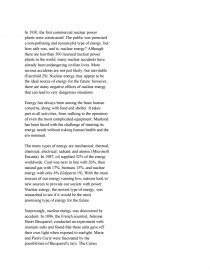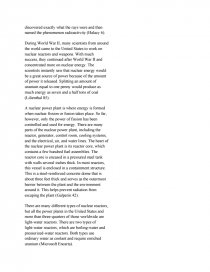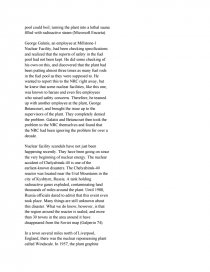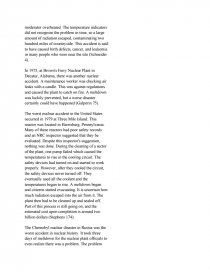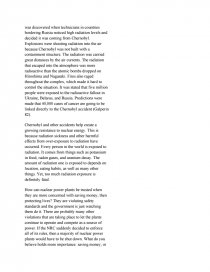The Negative Effects of Nuclear Energy
Essay by review • August 24, 2010 • Essay • 1,852 Words (8 Pages) • 4,282 Views
In 1950, the first commercial nuclear power
plants were constructed. The public was promised
a non-polluting and resourceful type of energy, but
how safe was, and is, nuclear energy? Although
there are less than 500 licensed nuclear power
plants in the world, many nuclear accidents have
already been endangering civilian lives. More
serious accidents are not just likely, but inevitable
(Fairchild 29). Nuclear energy may appear to be
the ideal source of energy for the future: however,
there are many negative effects of nuclear energy
that can lead to very dangerous situations.
Energy has always been among the basic human
concerns, along with food and shelter. It takes
part in all activities, from walking to the operation
of even the most complicated equipment. Mankind
has been faced with the challenge of meeting its
energy needs without risking human health and the
environment.
The many types of energy are mechanical, thermal,
chemical, electrical, radiant, and atomic (Microsoft
Encarta). In 1987, oil supplied 32% of the energy
worldwide. Coal was next in line with 26%, then
natural gas with 17%, biomass 15%, and nuclear
energy with only 4% (Galperin 19). With the main
sources of our energy running low, nations look to
new sources to provide our society with power.
Nuclear energy, the newest type of energy, was
researched to see if it would be the most
promising type of energy for the future.
Surprisingly, nuclear energy was discovered by
accident. In 1896, the French scientist, Antoine
Henri Becquerel, conducted an experiment with
uranium salts and found that these salts gave off
their own light when exposed to sunlight. Marie
and Pierre Curie were fascinated by the
possibilities of Becquerel's rays. The Curies
discovered exactly what the rays were and then
named the phenomenon radioactivity (Halacy 6).
During World War II, many scientists from around
the world came to the United States to work on
nuclear reactors and weapons. With much
success, they continued after World War II and
concentrated more on nuclear energy. The
scientists instantly saw that nuclear energy would
be a great source of power because of the amount
of power it released. Splitting an amount of
uranium equal to one penny would produce as
much energy as seven and a half tons of coal
(Lilienthal 85).
A nuclear power plant is where energy is formed
when nuclear fission or fusion takes place. So far,
however, only the power of fission has been
controlled and used for energy. There are many
parts of the nuclear power plant, including the
reactor, generator, control room, cooling systems,
and the electrical, air, and water lines. The heart of
the nuclear power plant is its reactor core, which
contains a few hundred fuel assemblies. The
reactor core is encased in a pressured steel tank
with walls several inches thick. In most reactors,
this vessel is enclosed in a containment structure.
This is a steel-reinforced concrete dome that is
about three feet thick and serves as the outermost
barrier between the plant and the environment
around it. This helps prevent radiation from
escaping the plant (Galperin 42).
There are many different types of nuclear reactors,
but all the power plants in the United States and
more than three-quarters of those worldwide are
light-water reactors. There are two types of
light-water reactors, which are boiling-water and
pressurized-water reactors. Both types use
ordinary water as coolant and require enriched
uranium (Microsoft Encarta).
In boiling-water reactors, cooling water surrounds
fuel assemblies. The heat of nuclear fission makes
the water boil and the steam produced is carried
away from the core to the turbines. Once its work
is done, the steam is condensed to water and it
returns to the reactor (Galperin 44).
The pressurized-water reactor is more commonly
used than the boiling-water
...
...
